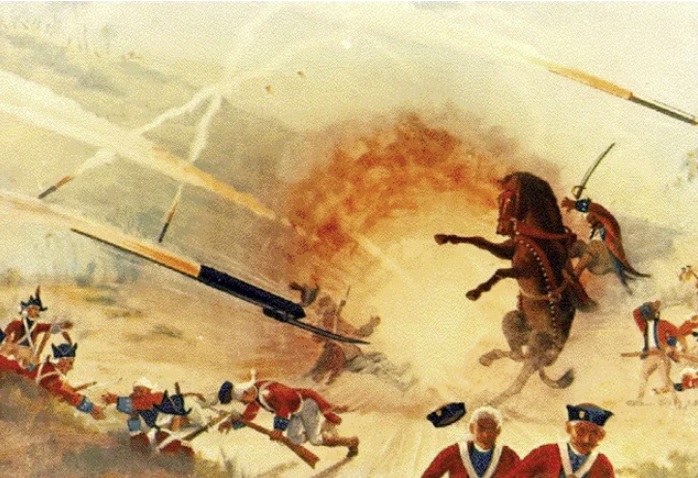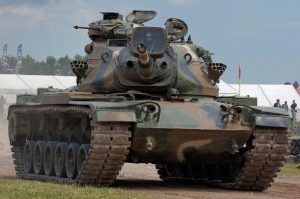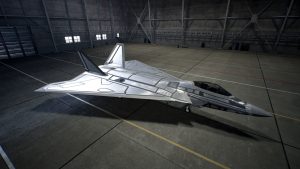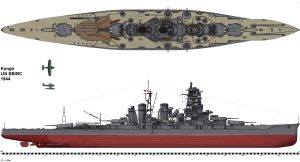
In 1770s, when the fledgling United States of America was striving for independence from Britain, the exotic name Hyder Ally (An anglicized form of Haidar Ali) was popular. This ruler of the Mysore Kingdom in south Asia had racehorses named after him and his military son Tipu Sultan. Early in the 1780s, Haidar Ali’s valor was cited in one of the earliest documented US Navy recruitments. A ship bearing his name contributed to one of the United States’ finest naval triumphs during the same time period. In 1781, his name was sung in the streets of America. Let’s go back in time in order to comprehend this.

In 1775, thirteen British colonies on the east coast of North America saw a huge upheaval as their citizens rebelled against the British government, declared independence, and raised their own flags (1, 2). The first banner of the Union, now the US national flag- the Stars and Stripes, sent to the state of Maryland was hosted on a sailboat by adolescent Joshua Barney at Baltimore in October 1775. Barney had just begun his service in the United States Navy.

A few years later, in 1780, in the distant Kingdom of Mysore, the East India Company suffered one of its worst military defeats in history. This occurred at the hands of Haidar Ali and his son Tipu Sultan, who France, an ally of the United States, backed. In September 1780, the humiliation of the British at the Battle of Pollilur reverberated in America when the word reached the nation (3). On October 19, 1781, the British land force led by Charles Cornwallis surrendered to the Americans led by George Washington (incidentally, a decade later in India, Cornwallis gave East India Company and its Indian allies victory over Haidar Ali’s son Tipu Sultan in the 3rd Anglo Mysore War). The surrender of Cornwallis and Haidar Ali’s successes in India was celebrated nine days later at Trenton, New Jersey. On that day, the town was decked with American flags. Residents, including the Who’s Who, attended a service at the Presbyterian Church, where a Reverend delivered a sermon stressing the significance of the occasion. In the afternoon, the gathering drank 13 toasts accompanied with a discharge of artillery, number eleven of which was for ‘The great and heroic Hyder Ali, raised up by Providence to avenge the numberless cruelties perpetrated by the English on his unoffending countrymen, and to check the insolence and reduce the power of Britain in the East Indies ‘(ibid., ref. 3). (ibid., ref. 3).
Hyder Ally and America’s Struggle Against the British to Reclaim Its Seas

Despite this, America was not an independent nation. The British continued to rule the oceans. They kept a close eye on ships entering and leaving the ports of the northeastern United States, frequently seizing ships and plundering their cargo. The American sloop-of-war General Washington was captured by Admiral Arbuthnot and placed in the king’s service under the new name The General Monk. It was then employed by American pirate ships. By 1782, Philadelphia City’s economy and the standard of living along the coast and neighboring waterways were degrading. The young American Union was incapable of protecting the affected vessels. Therefore, at its own expense, the Commonwealth of Pennsylvania outfitted a number of armed warships that operated in waterways leading to Philadelphia. The state purchased Hyder Ally, a tiny sloop (single mast ship) armed with sixteen six-pounder cannons to help guard the American vessels. 23-year-old Lieutenant Joshua Barney, now in the US navy, landed in Philadelphia, where he was bestowed with the command of Hyder Ally (4). (4). Barney, who was tasked with recruiting men, used a poem by Philip Morin Freneau to entice young American men to join the ship. With the following lines (5), the poem lauded Haidar Ali’s courage against the British:
Come, all ye lads who know no fear, To wealth and honour with me steer In the Hyder Ali privateer, Commanded by brave Barney. From an eastern prince she takes her name, Who, smit with freedom's sacred flame, Usurping Britons brought to shame, His country's wrongs avenging; Come, all ye lads that know no fear. With hand and heart united all Prepared to conqueror to fall. Attend, my lads! to honor's call — Embark in our Hyder-Ally!
Eventually, Barney commanded a group of one hundred and ten soldiers. On April 8, 1782, he got instructions to protect a fleet of merchantmen to the Capes immediately before the sea at the mouth of Delaware Bay. As he waited for a favorable wind to send the merchant ship out to sea after abandoning the convoy at Cape May road, he spotted three ships (6) that he realized were waiting to plunder the convoy. Barney promptly maneuvered the convoy back into the harbor, using Hyder Ally to cover the retreat. Soon, the larger General Monk, under the supervision of Captain Rogers of the Royal Navy, had doubled his own metal force, and roughly one-fourth outnumbered Hyder Ally’s men. Despite being fired upon, Barney held off Hyder Ally’s fire until the two vessels were entangled, which was within handgun range. A brief yet intense battle ensued. General Monk lowered her flags, signifying her surrender, after 26 minutes of fighting. Both warships arrived in Philadelphia with their respective dead a few hours after the battle. The Hyder Ally had four men dead and eleven injured. Twenty men were killed, and thirty-three were injured on the General Monk, including Captain Rogers and every officer on board, with the exception of one midshipman. (7)

A hero is honored.
Philadelphia erupted in revelry. On account of this magnificent victory, ballads were composed and sung across the city’s streets! Hyder Ally’s name echoed Barney’s (ibid., ref. 1). Here are some lines:
And fortune still, that crowns the brave Shall guard us over the gloomy wave — A fearful heart betrays a knave! Success to the Hyder-Ally! While the roaring Hyder-Ally Covered over his decks with dead! When from their tops, their dead men tumbled And the streams of blood did flow, Then their proudest hopes were humbled By their brave inferior foe.

In 1782, the Pennsylvania legislature voted a resolution of gratitude to Captain Barney and authorized the preparation of a gold-hilted sword, which Governor Dickinson handed to him on behalf of the state. It was a tiny sword with chased gold mountings, the guard of which bore an image of the Hyder Ally on one side and General Monk on the other (ibid., ref. 1). Barney was the last officer to leave the Union’s service in July 1784, having been the last officer kept by the United States for many months prior.
The American Government sent Barney to Paris. In France, he was honored as a hero for his daring maritime exploits during the American Revolution (8). A painting depicting the combat between the two ships was created by L. P. Crepin in Paris in 1802 at Barney’s request while he was serving the French Republic. On his return to United States, he delivered the same to Robert Smith, Esquire, then secretary of the navy (9). The painting is presented in the United States Naval Academy, Annapolis, Maryland (ibid., ref. 1). (ibid., ref. 1). Barney was a close friend of one of Napoleon’s generals, Count Bertrand (ibid., ref. 2). During Tipu Sultan’s lifetime, Napoleon formed an alliance against the British with Haidar Ali’s son, Tipu Sultan (10).
Barney was named a captain in the Flotilla Service of the United States Navy on April 25, 1814. (11). He fought in seventeen battles during the American Revolution and nine during the War of 1812. In August 1814, a British Musket Ball was lodged in his body during the engagement at Bladensburg, Maryland (12). He died on December 1, 1818, at the age of sixty.
Today, the globe is regarded as a global village due to the diminishing barriers between country states and individuals. But it may surprise us that even in the 18th century, seemingly local political events and persons impacted regions and communities far away. The fact that the name Haidar Ali, after an explorer from an obscure place in the former Kingdom of Mysore who taught the global colonial powers of England and France many lessons in military and political strategy, has echoed across the proverbial seven seas in distant North America for nearly a century is evidence of this (13, 14).

Portrait of Commodore Joshua Barney at Philadelphia’s Independence Hall. Life of Commodore Joshua Barney, Hero of the US Navy (1776-1812), 1912.
James Cooper wrote, 70 years after Hyder Ally’s triumph over General Monk, “This action has been justly rated one of the most magnificent under the American Flag. It was fought in the face of a greatly larger force that was not engaged, and the ship seized was in every vital regard superior to her conqueror.” (ibid., ref. 4)





